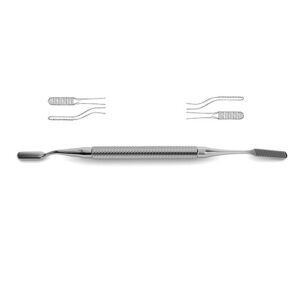| Name | Bone Rasp |
| Lead Time | 0-3 days |
| Specialty | Neuro, Ortho & Spine-Rasps & Files |
| Material Finish | Stainless Steel |
| Grade | Premium Operating Room |
| Units of Measurement | Each |
| Manufacturer | seemab surgical |
| Sterility | Non-Sterile |
| Usage | Reusable |
Bone Rasp
bayonet, 1 side flat & 1 side convex w/ cross-serrations, 9-1/2″ (24.0 cm)Bone Rasp is designed to aid in manipulation of bone and other hard tissue surfaces. It can be used to scrape or file away at these surfaces to give them a smoother finish for a variety of reasons. Mainly it is well suited for use in neurosurgical or orthopedic surgeries because these coarse bony areas can cause damage to surrounding tissue if they are not evened out with a file or raspatory. This rasp is a bayonet style and features one flat size and one convex side with cross-serrations that makes it well suited for filing.
SKU:
VI-01-1240
Category: Rasps & Files
Description
Shipping & Delivery
Related products
Nail & Bone Rasp
double ended, backwards cutting, 6-3/4" (17.1 cm)?Nail and Bone Rasp is ideal for a number of different neurosurgical orthopedic type surgeries. This rasp is double ended making it a two in one and can quickly switch between thw two heads. It has the ability to be backwards cutting. This instrument features serrations that allow either end to be used to whittle down or smooth roughened surfaces. In craniotomies or spinal surgeries such jagged edges can cause tearing on delicate tissue such as brain tissue or individual nerves and vasculature.
Bone File #33
double-ended, plain serrations, 6.0 mm & 5.0 mm wide ends, 7" (17.5 cm)?Bone File #33 is ideally suit for use in neurosurgical and orthopedic surgeries that require manipulation of bone in and around delicate tissue structures. This type of instrument can be useful in filing down the skull in procedures like craniotomies or in reshaping the vertebral arch during laminectomies or hemi-laminectomies. This gives added protection to the brain tissue or neurovascular bundles that can pass over these cut surfaces that may be jagged and could cause additionally injury or trauma. Additionally this file is double ended with plain serrations and features a 6.0 mm and 5.0 mm wide ends.
Gallaher Rasp
straight, coarse teeth, 6.5" (16.5 cm)?Gallaher Rasp is ideally suited for use in shaping or whittling down bone and other hard tissue. It can aid in prevention of further trauma or injury to soft tissue layers such as brain in craniotomies or to the spinal cord or neurovascular bundles in laminectomies. A unique feature of this rasp is the additional loop affixed to the base of the handle for placement of the thumb for added grip and maneuvering. Additionally this rasp is straight and features coarse teeth.
Bone File – Double-Ended
double-ended, cross-cut, 7" (18.0 cm)?Bone File is a highly versatile instrument that can be used in a vast array of surgical procedures. This file is double ended and is cross cut. The small paddle style blades allow it to be used near delicate tissue areas as are common in neurosurgical procedures and not cause trauma or injury by puncture wound. Additionally use of this file on jagged bone breaks or cuts or even on rough hard surfaces aids in the protected of neurovascular bundles and other tissue layers that are mobilized during surgery that can easily be torn or injured.
Putti Bone Rasp – Flat Blades
flat blades, double-ended flat blades, 18.0 mm width tapers to 4.0 mm, 1 end curved up, 1 end curved sideways, 10-1/2" (26.5 cm)Putti Bone Rasp is an instrument ideally suited for use in surgeries that require handling and particularly mild reshaping of bone such as in neurosurgical or orthopedic surgeries. . This instrument is double ended and features two flat blades. The unique design of this rasp is in the leap shaped silhouette that tapers from 18.00 mm to 4.0 mm that allows it to be fit into slim and narrow spaces and effectively whittle down bone or hard tissue from any angle.
Bone File #12
double-ended, plain serrations, 7.0 mm & 5.0 mm wide ends, 7" (17.5 cm)?Bone File #12 can be used in a variety of surgical interventions in neurosurgery or orthopedic surgery. This instrument is double ended with each end featuring plain serrations. It is ideally suited for use in filing bones such as reducing a sharp or jagged bone edge to prevent damage to surround tissue or delicate neuro-vascular bundles. Additionally each even here is a different width: 7.0 mm and 5.0 mm making it versatile enough to be used in a number of different surgical scenarios and can satisfy any surgeon preference.
Polokoff Bone File
Polokoff Bone File is a widely used instrument in surgery to aid in mild bone reshaping. Orthopedic neurosurgical procedures such as craniotomies or spinal surgeries such as discectomies require manipulation and handling of very delicate tissue such as nerves or brain tissue itself as well as a vast amount of vasculature. This file can be used to reshape or whittle down bone fragments that are sharp or jagged and could cause injury to any of the above tissue. Additionally this file is available with a short head and fine serrations or a long head with medium serrations.
Miller-Colburn File
double-ended, down-cutting teeth, medium & large ends, octagonal handle, 7-1/4" (18.4 cm)?Miller-Colburn File can be used to soften jagged edges or rough surfaces on bone or other hard surfaces. This file features a slim, octagonal body shaft that doubles as a handle from which two different sizes blade extend on either side. Both ends features down-cutting teeth that allow it to grab hold and uniformly file away at a surface such as the skull or vertebral fragment to protect surrounding tissue from damage in craniotomies or spinal surgeries.













